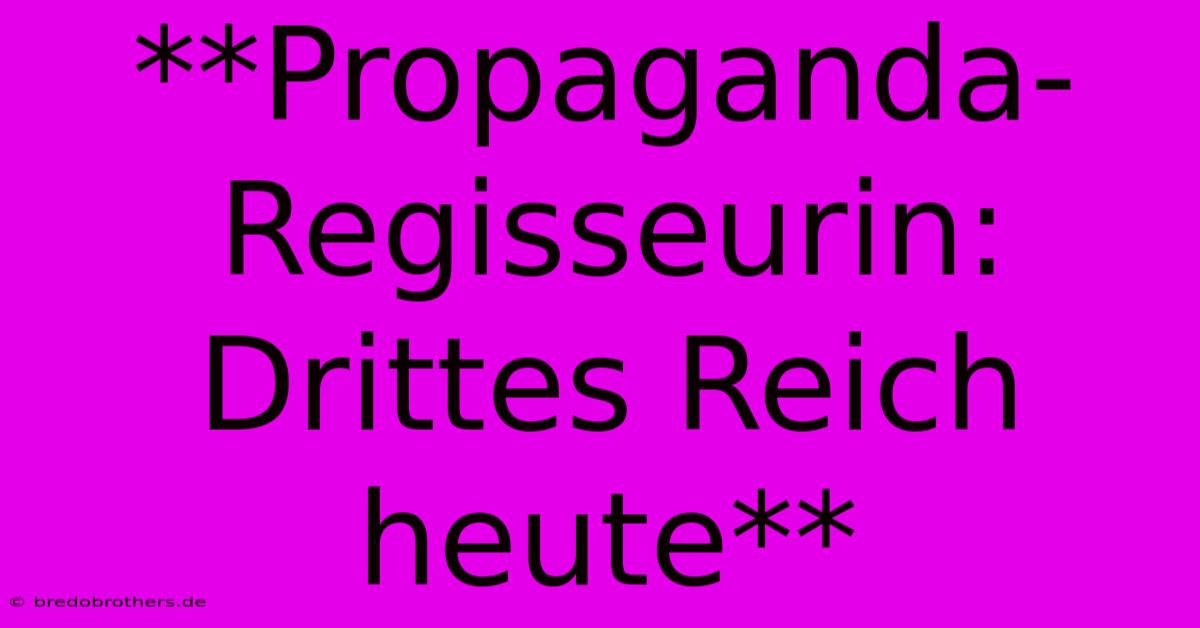**Propaganda-Regisseurin: Drittes Reich Heute**

Discover more detailed and exciting information on our website. Click the link below to start your adventure: Visit Best Website **Propaganda-Regisseurin: Drittes Reich Heute**. Don't miss out!
Table of Contents
Propaganda-Regisseurin: Drittes Reich heute – Ein Blick in die Vergangenheit, um die Gegenwart zu verstehen
Hey Leute! Let's talk about something kinda heavy, but super important: Propaganda im Dritten Reich, and how its echoes still resonate today. I'm not a history professor, just someone who's been obsessed with this topic for years. I mean, seriously obsessed. I even wrote my college thesis on Leni Riefenstahl – talk about a deep dive!
Leni Riefenstahl: More Than Just a Pretty Face
Initially, I was captivated by Riefenstahl's visual artistry. Triumph des Willens is undeniably stunning, technically brilliant. The cinematography, the masterful use of angles…it's breathtaking. But then, the nausea hit. Understanding the context, the horrifying propaganda machine she fueled, completely changed my perspective. It wasn't just about aesthetics; it was about manipulating an entire nation. That's where the real horror lies.
I remember one particularly frustrating moment. I spent weeks poring over footage, trying to separate the artistic merit from the political message – it's like trying to untangle a Gordian knot. It's impossible to fully appreciate the film's technical aspects without acknowledging its insidious purpose. And that realization? That was a gut punch.
Propaganda Techniques: Then and Now
The techniques Riefenstahl used – powerful imagery, emotional appeals, repetition, the glorification of a single leader – they're still used today. Think about it: slick advertising campaigns, emotionally charged political rallies, the endless stream of curated social media posts… it's all eerily similar. It's propaganda, repackaged.
One thing I learned – and this is crucial – is the importance of media literacy. We need to be critical consumers of information, to question narratives, to look beyond the surface. Don't just passively absorb what's thrown at you. Dig deeper. Research different perspectives. This isn't just about history lessons; it's about protecting ourselves from manipulation in the digital age.
The Dangers of Uncritical Acceptance
My initial mistake was focusing solely on the artistic aspects of Riefenstahl's work. I was so impressed by the technical skill that I almost ignored the ethical implications. It’s like being wowed by a beautifully crafted poison apple. It’s beautiful, but deadly. That's why understanding the historical context is absolutely crucial.
Practical Tips for Identifying Propaganda
Here's what I've learned to look for:
- Oversimplification: Does the message reduce complex issues to simple good vs. evil narratives?
- Emotional Manipulation: Does it rely heavily on fear, anger, or patriotism to sway your opinion?
- One-Sidedness: Does it present only one perspective, ignoring dissenting voices?
- Repetition and Slogans: Are simple, catchy phrases repeated endlessly?
- Loaded Language: Does the language used evoke strong emotional responses?
This isn't easy stuff. It requires constant vigilance and a healthy dose of skepticism. But it's essential if we want to navigate the information landscape responsibly. We need to be smart consumers, actively combating the subtle—and not-so-subtle—forms of propaganda that surround us daily. We need to be critical of the visual language around us, just like I eventually learned to do with Riefenstahl's work.
So, yeah, studying Riefenstahl and the propaganda of the Third Reich has been a wild ride. It's been frustrating, eye-opening, and ultimately, incredibly important. Let's learn from the past to better understand and resist the propaganda of today. What are your thoughts? Let's chat in the comments!

Thank you for visiting our website wich cover about **Propaganda-Regisseurin: Drittes Reich Heute**. We hope the information provided has been useful to you. Feel free to contact us if you have any questions or need further assistance. See you next time and dont miss to bookmark.
Featured Posts
-
Ukraine Angriff Russland Berichte
Nov 21, 2024
-
Disney Plus The Rookie Staffel 6
Nov 21, 2024
-
Schweizer Curling Team Siegt Erneut In Finnland
Nov 21, 2024
-
Mdax Aurubis Gewinn Seit 2022
Nov 21, 2024
-
Meinl Reisingers Neue Positionen Fokus Auf Die Neuen Positionen
Nov 21, 2024
